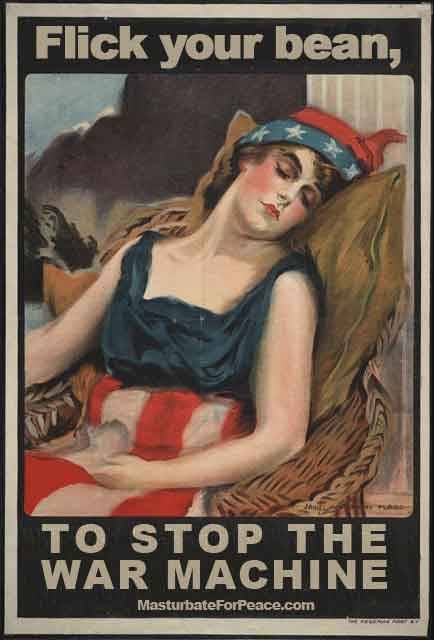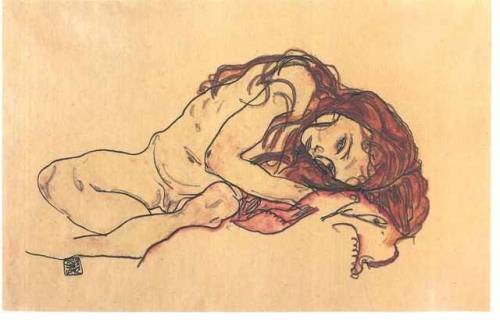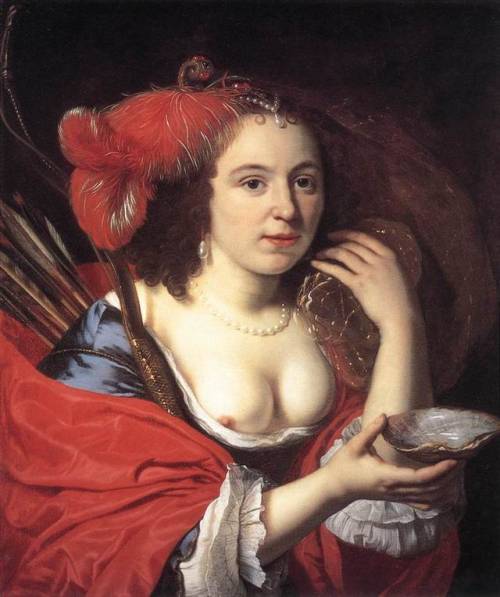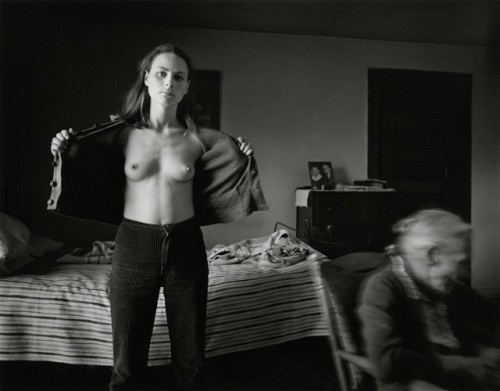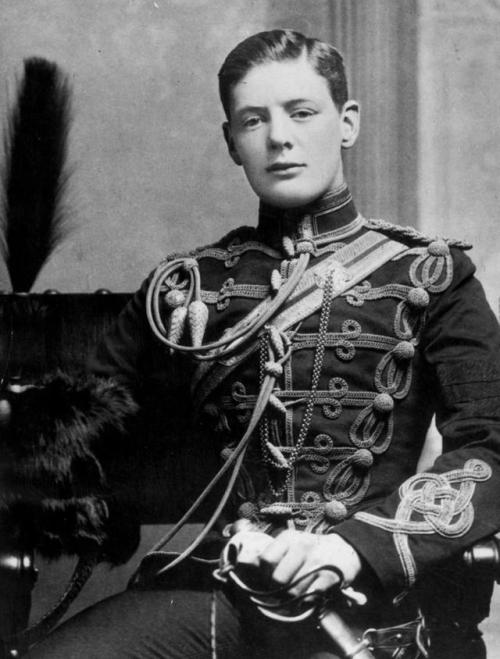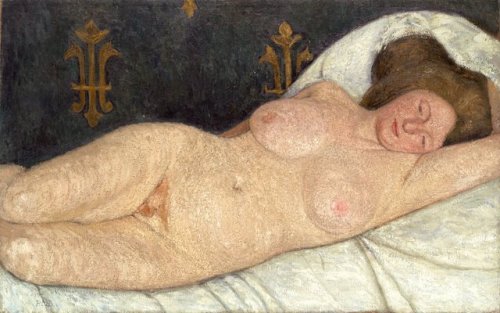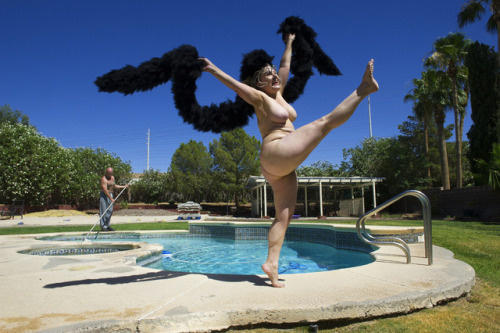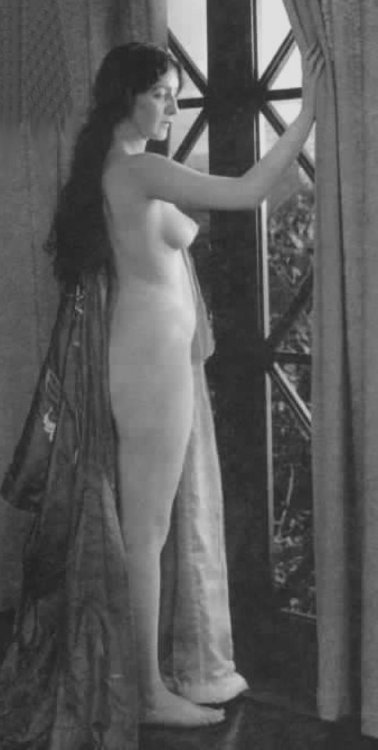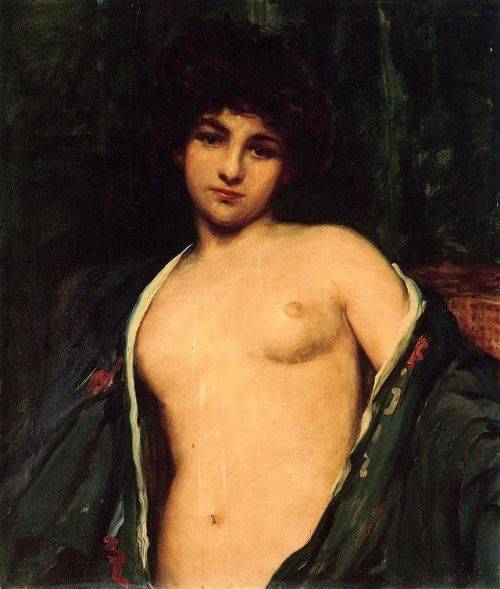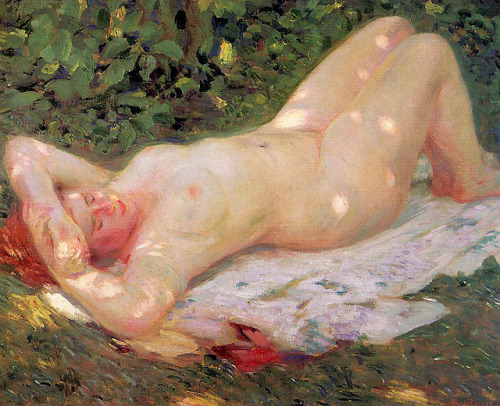#nakedhistorylessons
Military recruitment parody posters by Masturbate For Peace, 2002.
Though it didn’t enter World War I until 1917, the United States produced more posters in support of mobilization and civilian service than any other country. The government established a Department of Pictorial Publicity with 300 artists who were ordered to “draw until it hurts.”
The backlash fifty years later against the Vietnam War included the co-opting by activists of propaganda posters. They substituted anti-military themes, often featuring the slogan, “Make Love, Not War.”

Joan Baez and her sisters Mimi and Pauline posed for a poster challenging the popular notion that refusing to serve was cowardly or unmanly. Their message, that liberated women would have sex with draft dodgers, perhaps recalls the heroine Lysistrata, who organized a chastity movement among Greek wives to force peace negotiations.
Post link
(tw: allegations of incest and sexual abuse)
Crouching female nude with bended head by Egon Schiele, 1918.
On June 18th, 1915, three days after his wedding, Schiele was conscripted into the Austrian army. Due to his excellence in handwriting, he spent most of the war working as a clerk in a POW camp. He continued to draw, encouraged by his commanding officer.
Despite avoiding action on the front lines, Schiele did not survive to see the Armistice. His wife, six months pregnant, fell victim to the Spanish Influenza pandemic on Oct. 28th, 1918. Schiele, who had also contracted the disease, capitulated three days later. He was 28.
One hundred years after his death, Schiele is categorized with a group of erotic artists that includes one of his mentors, Gustav Klimt. I’m not sure that’s the right place for Schiele, as although his major works have sexual themes, they are often grotesque.
In 1912, Schiele was arrested for seducing a girl under the age of consent. He was ultimately convicted on a lesser charge of showing pornography to a child. He may also have initiated an incestuous relationship with his sister, Gerti, when she was 12. On at least one occasion, he was forced to move out of town due to suspicions he had molested teenage girls posing for him.
Whereas Klimt unabashedly celebrated eroticism, I think Schiele had a much darker perspective on sexuality. Although there can be beauty in brutality, Schiele’s work is tinged by a sense of repulsion, perhaps self-directed.
The gap of time does not allow for confirmation or rejection of the rumours surrounding Schiele, The art he left behind, however, has a distorted and delinquent quality (for example, the portrayal of the genitals of the redheaded model, above) which–and mine is a minority opinion–isn’t so sexy.
Post link
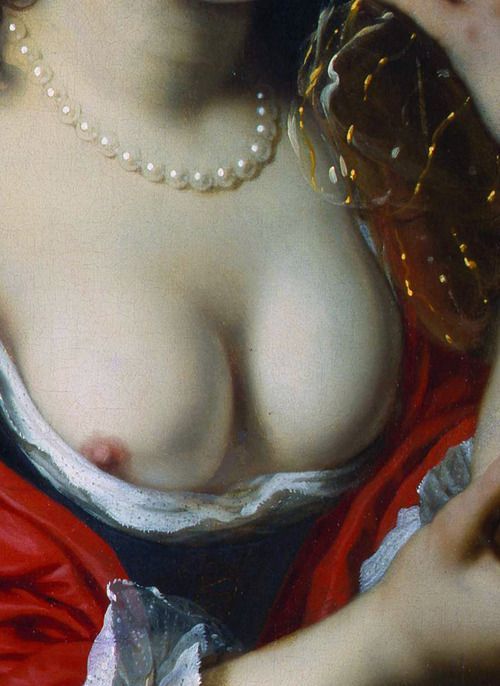
Anna du Pire as Granida (with detail) by Bartholomeus van der Heist, 1660.
In Holland during the 17th century, the fashion among the nobility was to be painted as characters from pastoral plays.
Grandia is the heroine of a platonic love story named for her and rewritten for the stage by Pieter Corneliszoon Hooft in 1605. A princess from Persia, she is rescued by a kindly shepherd after she loses her way during a hunt.
The excuse that the model was not herself but instead the embodiment of a literary fiction allowed for costumes that were otherwise too racy in a society shaped by puritan influences.
The exposed nipple may still have been intolerable for some viewers but van der Heist had another advantage to help sway public opinion: Anna du Pire’s husband approved of the picture. Indeed, he had painted it.
Post link
Poor Austria, land of lederhausen and edelweiss, lonely goatherds and singing nuns: Rogers and Hammerstein sliced off your balls and made you the eunuch of Europe, at least as seen through North American eyes.
Crossing the ocean to pay homage to the musical, pilgrims will soon discover they were mislead. Austria is virile. The hills are alive with the sounds of orgasms. Sex work is legal (though regulated) in most Austrian provinces and the country has a lively sauna culture, usually with no gender segregation. Spas, pools and lakeside beaches often have “free body culture” zones–invitations to go skinny dipping–and television commercials may feature naked people selling coffee or cars. An academic study concluded that women in Austria are the most sexually-satisfied in the world.
Now, exporting sex- and body-positive values might get a country in trouble (even if those are things badly needed in most places.) Austria’s Post Office, however, has come up with a subtle way of sharing the pleasures of sexual freedom and equality in the bedroom: issuing stamps decorated with artistic erotica.
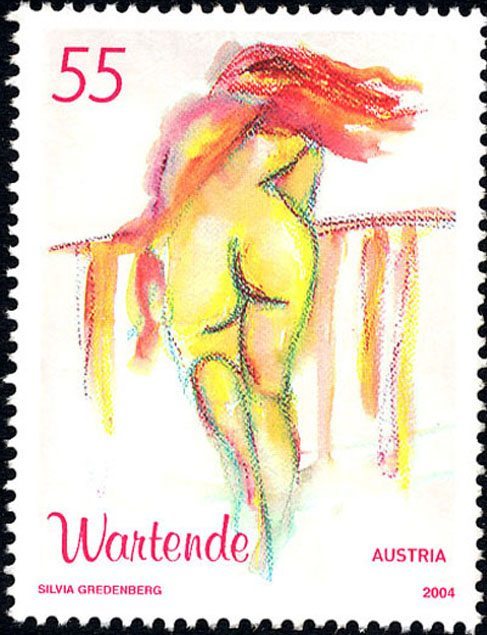
Both of those stamps are gorgeous and the artists, Dina Larot (top) and Silvia Gredenberg, deserve the recognition. Highlighting art by women seems appropriately Austrian, too–but perhaps the greatest painter in the erotic genre, Gustav Klimt, is not ignored.


What’s that I hear? You prefer your stamp nudity to be more masculine? Well, Austria really does have something for everyone. You can even see penis.


Both models, by the way, are rendered by women: Cornelia Schlesinger (top) and Astrid Bernhart.
So, have Austrians always appreciated the nude in art? That’s hard to know. We can only go back about 27,000 years. As you would probably expect by now, yes, that item is featured on one of the country’s stamps, too:

Post link
If you set out to make pictures about love, it can’t be done. But you can make pictures, and you can be in love. In that way, people sense the authenticity of what you do.
- Emmet Gowin
Three images, all taboo, yet infused with gentleness. The subject is Gowin’s wife, Edith, whom he married in 1964. Knowing that changes something. It adds an invasive intimacy–a summoning to a place where an outsider is not supposed to go.
The out-of-focus woman in the first photograph is Edith’s grandmother. Her presence shouldn’t conjure discomfort; nor should Gowin’s, unseen behind the camera. But they are not supposed to be there at the same time, not when Edith’s breasts are exposed in such a determined way. Particularly in his early work, Gowin suggests that the alienation of family from sexuality is inauthentic. Sex, after all, is part of what creates families. He knew this message was open to misinterpretation. “Everyone thought my photographs were incestuous,” he remembers in a 2014 Guardian interview. Of course, that was not his purpose. He saw the same wonder in everyday familial relationships that others go to mountains or jungles to witness.
According to artist Chris Wiley, the second picture of the set, which shows Edith urinating in a barn, is “the most intimate photograph.” He’s not limiting himself to Gowin’s portfolio. Of all the images in the world, it is the one that “brings love near enough we can feel it’s hot breath.” Wiley writes:
The picture is so piercingly intimate that I find it difficult even to look at it. This is not because I feel as if I am intruding, or being shown something that I was not meant to see, but simply because it seems to hover too close to the vital force of human connection. It is too poignant, too alive.
When skimming explicit photographs on the Internet late at night, you’re sure to encounter pictures of people peeing. For me, they have this terrible effect of causing mindfulness of my bladder, forcing my sleepy body out of bed for a trip to the bathroom. Such images are not really intimate, despite the subject matter; rather, they are bold and confrontational.
Wiley’s private moment with Edith doesn’t offer anything for the fetishist–unless being in love in a intensely familiar way counts as a fetish.
The last photograph features no grandmas in rocking chairs or puddles of urine, but for me it is the edgiest and best illustrates the concept of loving trust. Edith’s pose is not flattering. Seen out of context, perhaps the viewer would misinterpret Gowin’s intention as a meditation on the entropy of old age.
The miracle of lasting love is that we never stop seeing beauty in the bodies of our partners. Though the image is not romantic, I feel overwhelmed by the photographer’s affection for the creases of his wife’s neck, the slouch of her breasts and the folds of her stomach.
Then there is Edith’s faith, purer than the most zealous nun’s belief in God, that Gowin will see her accurately yet love her as devotedly as he always has, always will.
Post link
Scott Church takes pictures for Playboy, Penthouse and Hustler, but his range is broader than the merely pornographic.
Actually, I don’t like that sentence. The ultimate naked history lesson is that trying to draw a line between pornography and erotica is futile. Let’s go with:
Scott Church takes pictures.
Ah, much better.
Post link
Having an umbrella can come in handy.
On humid summer afternoons, thunderclouds invade the cornflower skies of the Upper Northwest, leaving Minneapolis sidewalks drenched in puddles of purple rain.
The epicenter is often the First Avenue and 7th Street Entry, built as a bus depot but converted into a music venue. Joe Cocker played two sets there on opening night, April 3rd, 1970.
Fourteen years later, a local talent made First Avenue famous. Prince rented the club for $100,000 over 25 days to serve as the main location for his first film. The soundtrack for Purple Rain included Let’s Go Crazy and When Doves Cry and earned an Academy Award. Prince simultaneously had the top single, album and film in the United States.
He continued to visit First Avenue is subsequent decades, both to perform and listen to new musicians. On the day Prince died in 2016, more than 10,000 people converged near the venue for an impromptu celebration of his life.
(Photograph by Scott Church from DeviantArt.)
Post link
Erosion No. 2: Mother Earth Laid Bare by Alexandre Hogue, 1938.
From the murals funded by the Works Progressive Administration to John Steinbeck’s Grapes of Wrath, the artistic output of the Great Depression generally depicted Dust Bowl farmers as victims of an environment and an economy turned savage.
Alexandre Hogue insisted on a different narrative: the recklessness of human agriculture, enhanced by mechanization, funded by capitalism, had raped the essence of the land.
His paintings show no sympathy for the refugees moving to California or the families that stayed behind, living on New Deal welfare. For desecrating the sacred earth, they deserved the revenge nature was inflicting upon them.
Scientific discoveries in land reclamation and the development of new farming methods, funded by the Roosevelt Administration, partially restored harmony to the ecosystem. However, many homesteaders remained reluctant to accept the reforms. The government had to pay a dollar per acre to early adopters to encourage compliance.
As humanity stumbles into a warming climate, a new Dust Bowl, I suspect more artists will adopt Hogue’s point of view this time. It feels like we have forsaken the privilege of sympathy.
Post link
From Her Body Sprang Their Greatest Wealth by Nona Faustine, 2013.
The photograph was taken at the site of the Colonial Slave Market on Wall Street, which operated from 1711 to 1762. New York had the largest urban population of slaves in North America during the 18th century.
The closure had nothing to do with more enlightened views about race. City Council determined the market was “disagreeable to those that pass and repass to and from the Coffee House.”
Children and adults of African decent continued to be sold, legally and illegally, in New York until the mid-point of the Civil War.
In her White Shoes series, Faustine brings attention to city sites linked to the slave trade.
(Additional sources: Untapped CitiesandThe Establishment)
Post link
The body-positive and sex-positive community that meets on Tumblr may make up one the most important (and delightful) corners of the Internet. It is the place I most want to visit when I’m feeling sad: the beauty, intelligence and acceptance displayed in these blogs restore my sense of hope. Good things everywhere seem to be under attack these days and I know that some visitors come here to inflict harm. Other people are rude or thoughtless, but regardless of intent, the cumulative negativity dims the sunshine this part of Tumblr brings to the world. I don’t want to be a cloud on the horizon so I’m making this promise, which I hope addresses most of the concerns I hear from bloggers. Since I originally set out for this place to talk about the history of sexuality, I’ve looked back in time for a suitable model. Please let me know if I’ve missed something vital in my application for citizenship.
My “Adult” Tumblr oath, in the style of Hippocrates, to do no harm:
I swear by Aphrodite, goddess of pleasure, beauty and love and patroness of sex workers; by Eros, god of attraction and desire; and by Erato, muse of lusty and romantic poets (and by all the multicultural gods, goddesses and spiritual entities of similar character) as my witnesses, that I will carry out, according to my best ability and judgment, this oath and this indenture.
- That I will show love and respect to people of all abilities, heritages, sizes, orientations and gender identities.
- That I will speak out against bullying and attempts to cause pain.
- That I will remember the difference between equity and equality and not use my privilege to ignore, deny or judge the experiences of another person.
- That I will not follow bloggers who sanction the racism, sexism and anti-LGBT prejudices of the current American president.
- That I will strive to find beauty beyond the constraints and expectations of my culture.
- That I will respect the autonomy of people to make decisions about how they look and the work they do and not provide unsolicited advice.
- That I will not shame someone for being more or less sexually adventurous than me.
- That I will abide by requests attached to images posted by creators and maintain their credits.
- That I will make a reasonable attempt to identify the source of content which is not credited and follow through on requests from copyright holders to remove items not in the public domain.
- That I will not use the work of other creators to promote my blog or my business interests.
- That I will not pass along sexual content which appears to have been stolen or posted with malicious intent, including “doxing” and revenge porn.
- That I will do nothing to perpetuate the scourge of porn bots.
- That I will take a moment to ensure comments I’m about to add are kind, smart and appreciative.
- That I will not submit sexual content to anyone without clear consent nor use an explicit picture as my avatar.
- That I will respect pronoun preferences and acknowledge and correct any errors I may make.
- That I will mark my blog as being for adults and prevent anyone I know to be underage from following it.
- That I will try not to act like a creep or a jerk.
Now if I carry out this oath, and break it not, may I gain forever reputation among all people for my blog and my comments, but if I transgress it and forswear myself, may the opposite befall me.
Sworn on the 1st day of October, 2017
(Photograph of Cypriot Aphrodite statue, Creative Commons CC0.)
Post link
The Model (After Chaplin) by Paul Peel, 1890
Born in London, Ontario, Paul Peel was one of the first Canadian artists to adopt the subject of the nude. Such paintings were not possible in the early years of the Dominion because it was too cold to take off clothes.
(In fact, the breasts are probably parisienne. Peel often visited Europe to study and show his work.)
Critics complain about Peel’s traditional and sentimental style–too bourgeois, they say. Perhaps later in life he would have been more experimental, but he died of influenza, in France, at age 31.
(The Model is part of the collection of the Ontario Art Gallery.)
Post link
Perhaps because my life hasn’t followed a conventional gender script, I am fond of images that challenge stereotypes–and Katherine Hepburn was so formidable she doesn’t seem out of place at all.
Hepburn’s breakout performance came in a 1932 revival of The Warrior’s Husband (a riff on Lysistrata) when she played Antiope, sister of the queen and commander of the all-female armed forces in the Amazonian state of Pontus. For her stage entrance, Hepburn jumped down a flight of stairs while carrying the carcass of large stag on her shoulders.
An RKO scout in the audience one night, Leland Hayward, was so impressed with Hepburn’s physicality that he arranged a screen test. She made her Hollywood debut in George Cukor’s A Bill of Divorcement and by 1933 had earned her first Academy Award for Morning Glory, where she portrayed a young actress who sacrifices romance for the sake of her career.
Perhaps Hepburn had her early successes in mind when she said, “I never realized until lately that women were supposed to be the inferior sex.”
Post link
Decades before he would take on the Nazis, Cadet Winston Churchill of the Royal Military College at Sandhurst launched his first foray into (politicall) battle as the (self-appointed) champion of sex workers, brandishing his wit against the “prudes” who demanded stricter regulation of prostitution.
It was the Naughty Nineties and Churchill, grandson of the Duke of Marlborough and son of the former Chancellor of the Exchequer, was caught up in the excitement of the popular reaction against Victorian Puritanism. The young soldier’s passion was the music hall and his favorite venue was the Empire, which featured a men’s bar alongside a promenade where dollymops and toffers strolled, advertising their services, showing off their wares and negotiating their fees.
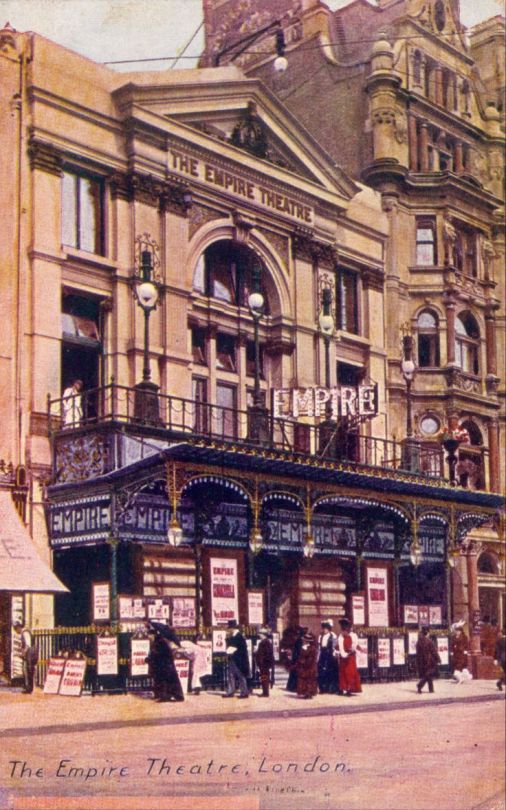
When a crusader against prostitution with a name suited for a Monty Python sketch, Mrs. Ormiston Chant, succeeded in persuading local officials to separate the courtesans from their potential clients with a barricade, Churchill mustered his burgeoning skills as a political activist. He hocked his watch for funds to support a protest and on the evening of the third day of November, 1894, three weeks shy of his twentieth birthday, the cadet hopped onto a chair among the tipsy Empire clientele and declared, “I stand for Liberty!”
His first public speech triggered a lawless outburst which culminated in the destruction of the barricade. The sense he could motivate people with his words intoxicated Churchill. “It was I who led the rioters,” he wrote excitedly to his younger brother.
The victory was temporary. The London County Council sided with Mrs. Chant and the barrier keeping the vices of alcohol and prostitution separate reappeared. The Bishop of London chastised Churchill in The Times: “I never expected to see an heir of Marlborough greeted by a flourish of strumpets.”
Unapologetic, the heir of Marlborough wrote to his aunt, “It is hard to say whether one dislikes the prudes or the weak-minded creatures who listen to them most. Both to me are extremely detestable.”
Was Cadet Churchill a personal patron of the sex workers? Probably not, historians say. A music hall girl who spent the night with him reported, “Winston had done nothing but talk into the small hours on the subject of himself.”
In power, Churchill did not pursue formal decriminalization, but he continued to believe that using the legal system to oppose sex workers was, as he once told his father, “coercive and futile.” Prostitution flourished in London during the Second World War; even the streets of posh Mayfair were crowded with businesswomen offering succor to young soldiers. Cabaret star Florence Desmond sang what may have been a typical sales pitch:
I’ve got a cozy flat.
There’s a place for your hat.
I wear a pink chiffon negligee gown.
And do I know my stuff,
But if that’s not enough,
I’ve got the deepest shelter in town.
Churchill later recalled the Empire incident in his official biography. The old warrior said his speech had been “a serious constitutional argument upon the inherent rights of British subjects; upon the dangers of State interference with the social habits of law-abiding persons; and upon the many evil consequences which inevitably follow upon repression….”
(Additional sources: First Lady: The Life and Wars of Clementine Churchill by Sonia Purnell; The Last Lion: Winston Spencer Churchill by William Manchester; London in the Twentieth Century: A City and its People by Jerry White.)
Post link
Reclining Female Nude by Paula Modersohn-Becker, ca. 1905
She is pretty without artifice, strong without giving up her sensuality, at once chaste and fecund.
Her contradictions anticipate the emerging feminism of the early 20th century: an aspiration that biology would not prescribe a woman’s destiny and that success would not require her to adopt a masculine affect.
The artist did not live to witness the effort to achieve her vision. Modersohn-Becker died in 1907, after the birth of her daughter. She was 31.
Post link
So Donny Trump wants to emasculate the American military by firing all the trans soldiers. (I see what I did there.)
This desecration of human rights is not something that can be casually brushed aside to start a conversation about the history of trans people fighting for their countries. Even if no evidence existed of transsexual, transgendered or two-spirited soldiers becoming battlefield heroes, this hideous embrace of discrimination would still be immoral.
Therefore, please consider this post to be part of a secondary argument: that women who biologically started life as boys and men who biologically started life as girls have served in armies with integrity and courage. The war against terror (or whatever it’s being called these days) will become harder to win (if that’s even possible) by Trump’s transphobia; in short, he is putting the lives of Americans at risk for the sake of his prejudices.
There’s a problem of language when examining the lives of this cadre of soldiers. Dr. Harry Benjamin coined the word transsexualism in its current meaning in 1953, while transgenderism does not appear in the lexicon until the late 1980s. In the absence of accurate words, it is difficult to distinguish between disguise, cross-dressing and sexual or gender identification. For Alonso Diaz Ramirez de Guzman, a conquistador, and British army surgeon Dr. James Barry (later Inspector General of Hospitals in Canada), I’d suggest trans is the appropriate term as they lived their entire adult lives as men.
Ramirez’s secret was revealed when he was wounded in 1624 while serving with the Spanish army in South America, but he had demonstrated such heroism–albeit in a cause we now consider despicable–that Pope Urban VIII issued a special dispensation that allowed Ramirez to continue to present as male.
Florence Nightingale recalled Barry (pictured below) as the “hardest creature I ever met.” The discovery of his typically female genitalia didn’t happen until his death of natural causes in 1865.

By contrast, I don’t think trans is the right word for Deborah Sampson, who enlisted in the American revolutionary forces as Robert Shirtliffe in 1778. She returned to her female identity after a doctor discovered her ruse and relayed his findings to George Washington, who discharged her from duty. She went on to marry a farmer and received a land grant and pension in recognition of her service. She was a woman who donned a disguise to help a cause she found inspiring, not someone whose gender and sex mismatched.
Memories passed down by elders as well at the accounts of missionaries confirm the participation of two-spirited people in tribal wars. The Cheyenne, Lakota Sioux, Mohave, Navaho, Zapotec and Zuni nations all have words for gender-variant people, suggesting they were more enlightened in some things than the Europeans who attempted to “civilize” them.
As an antidote to the phrase, “fights like a girl,” I’d like to offer a short recap of the life of Philippe I (top), Duke of Orléans and the younger brother of Louis XIV, the famous Sun King. I will use male pronouns to be consistent with the way Phillipe was addressed as a nobleman (and because it’s not clear whether trans or some other term would serve as the best descriptor.)
Queen Anne recognized her son’s disinterest in traditionally male activities when Philippe was young and encouraged him to dress in feminine clothing. Affectionately, she addressed him as “my little girl” and Anne’s friend, the Duchess of Montpensier, called Phillipe “the prettiest child in the world.”
(Below: Phillipe with Louis XIV, who ascended to the throne when he was four years old.)

When the young duke was old enough to participate in court society, he attended parties and dances clothed in female attire. For lovers, he chose other men, an acceptable practice as long as such dalliances remained discrete. Phillipe’s flamboyance made that difficult, particularly after he was married to Princess Henrietta of England, youngest daughter of Charles I. Whenever her husband became overly-infatuated with a new paramour, Henriette complained to the king. He would usually send Philippe’s boyfriend abroad, but after much pining and pleading, the duke would be able to get his brother to relent.
After Henrietta died, the pattern repeated during Phillipe’s second marriage to Princess Elizabeth Charlotte of Palatine, the daughter of an Elector of the Holy Roman Empire. Nevertheless, Phillipe fulfilled his dynastic duties, fathering seven children of whom four survived infancy. (A direct descendant of his, Louis Philippe, became King of the French in 1830.)
In his memoirs of Louis XIV’s court, Louis de Rouvroy, Duke of Saint-Simon, offers a description of the adult Phillipe:
He always dressed as a woman and was covered with rings, bracelets and precious stones everywhere. He wore a long wig, black and powdered, and ribbons wherever they could be placed. He was redolent of all kinds of perfumery and… wore rouge.
Historians would probably have dismissed Phillipe as a dandy but for one thing: he was an excellent military commander.
France invaded the Spanish Netherlands (now Belgium) in 1667, claiming that Spain’s failure to pay Louis a dowry of 500,000 gold pieces made him the rightful ruler of the territory. Members of the royal family were expected to lead their troops and Philippe did not shirk his duties. It was an easy campaign–Spain had just lost Portugal in a war of independence–but Philippe was able to gain a share of the glory through his courage and calmness under fire. Indeed, the soldiers under his command noted he had no fear of being killed, but instead worried about getting sunburned or having his clothes besmirched by gunpowder.
The War of Devolution was a military triumph for France but the peace treaty disappointed Louis. An English, Dutch and Swedish coalition, intent on preserving the balance of power, demanded the restoration of Spanish control over most of the conquered territory. France was only allowed to keep a few gains on the periphery.
Louis seethed for revenge, particularly against the Dutch, who had previously been French allies for more than a century. He invaded in 1672, this time with support from England and Sweden: bribing their kings proved to be a useful diplomatic tool. Again, France won a series a quick victories, which brought other European powers into the war to keep Louis in check and prompted his allies to withdraw their forces.
The decisive battle was fought at Cassel in 1677. Philippe, promoted to lieutenant general on merit, commanded a force of 30,000 soldiers facing an army of similar strength under William of Orange, the future King of England. The French won an overwhelming victory, killing or wounding 8,000 of their opponents.
Thus, Philippe became partly responsible for making his brother the most powerful man in the world.
Almost 450 years later, Cassel remains a French town. It served as Marshal Ferdinand Foch headquarters for part of the First World War.
His mission fulfilled, Philippe returned to his lands and his dresses. As good with money as he was with a sword, he brought in so much revenue that his branch of the family would eventually surpass the wealth of Bourbon royal line.
A stroke ended Philippe’s life on June 9th, 1701. His widow burned all the letters he’d received from lovers over the years, noting that their perfumed scent made her feel nauseous.
Not a mother’s instinct, nor a wardrobe full of women’s clothing, nor a touch of rouge on the cheeks are sufficient to declare someone trans. As for sexual orientation, it is independent from gender identity as a concept.
As Commander-in-Chief, would Trump welcome someone with Philippe’s qualities in his military? The answer is obvious, as are the consequences of refusing to enlist the person who potentially could change the world.
(Additional Sources: The People’s Almanac Book of Lists, vol 1, and the Dancing to Eagle Spirit Society)
Post link
Former burlesque star Brandi Duran, photographed by Marie Baronnet as part of her Legends series in 2014. She traveled across the United States taking pictures of retired exotic dancers, ages 60 to 95.
If these striptease dancers were pioneers in their field, they are equally pioneers in women’s emancipation, homosexuality and transsexuality. Breaking with the norms of a patriarchal society, they took fate into their own hands, traveling across the United States laden with suitcases and costumes as part of a day’s work. Their stories form part of the American saga and their bodies bear the traces today. Courageously, some of them were able to live their homosexuality and transsexuality during a particularly repressive time, emerging into womanhood by braving the law and the dangers presented by operations and unregulated products. (Source.)
Here’s Duran twirling her tassels as part of a ballerina routine:
Post link
In 1915, Audrey Munson became the first person to appear fully nude in a mainstream Hollywood movie.
Her body was already famous: as a model, she had posed for most of the famous sculptors of the era. You can see her likeness in the lobby of the Hotel Astor and on top of the Wisconsin State Capitol dome. At the Longfellow Memorial, she is Evangeline.
This new thing of nudity on film created a dilemma for the censors. If they decided Munson’s body was obscene, the popular public art based on her figure would also have to be suppressed. A compromise solved the problem of the slippery slope: Munson would always play an artist’s model, thereby limiting any association between nudity and sexuality.
Munson starred in four films, but only one, Purity, survives. In 1993, a copy was discovered locked up in a vault in France.
She actually used a body double–of sorts. Though Munson performed all the nude scenes, a lookalike actress named Jane Thomas stepped in on those occasions when the character wore clothes.
Munson preferred not to cover up when given the choice. She wrote: “Clothes ruined us. They do harm to our bodies and worse to our souls. So few young women of today know what to do with their hands, how to carry them and how to use them in company because their clothes are in the way.”
To an interviewer, she said, “No woman who is conscious of clothing is truly feminine or truly beautiful.” That went for makeup as well, though beauty’s greatest foe, she proclaimed in a column written for the New York American, was the garter belt.
Her life was long but not happy. Scandal broke in 1919 when her landlord killed his wife, allegedly to make himself eligible to marry Munson. She fled to Canada and though police eventually determined she was not an accessory to the crime, moralists perpetuated the scandal by feeding gossip to the tabloids. (Perhaps the garter belt lobby secretly funded their efforts.)
Her reputation ruined, Munson could not find work as an actress or a model. Depressed and impoverished, she drank bichloride of mercury, surviving the suicide attempt but likely damaging her brain. She was institutionalized in a psychiatric facility, where she remained until her death, in 1996, at the age of 104.
(Additional source: The Believer)
Post link
The Sleep of Endymion by Anne Louis Girodet de Roucy-Trioson, 1791.
A gorgeous man: that’s an oxymoron, right? At least it is in the current iteration of western culture– but the Greeks and Romans had other perspectives on male beauty.
Endymion, mythology’s loveliest mortal, is a young shepherd (not a hunter or warrior) sleeping away a sentence of 30 years for offending Juno. Over this period he will not age, and chaste Diana, goddess of the moon, shines her beams on him, playing the voyeur. Zephyr pulls back the branches of the laurel tree so she can get a better view.
Critics speculate that Girodet has rendered Endymion as effeminate or gay–an odd interpretation for such a vivid portrayal of heterosexual lust. Somehow that must seem less preposterous to them than the idea that a woman, a goddess, might enjoy checking out vulnerable, naked, gorgeous male flesh.
(Additional source: The Louvre)
Post link
Eartha Kitt in 1968, the same year her strong denunciation of the Vietnam War at a White House dinner made Lady Bird Johnson cry. The CIA retaliated by launching a smear campaign that claimed Kitt was “a sadistic nymphomaniac.”
An item from my old blog, but it would be worth sharing again just for the picture. I don’t think I’ve seen a more sultry look than the one Eartha Kitt delivers here. She has such an erotic power that many tears–not just those of the wife of a president–must have been shed over her.
Post link
Two Against the World by Ernst Ludwig Kirchner, 1924.
Dystopian authors such as Aldous Huxley and George Orwell proposed that the greatest threat to a totalitarian system would be romantic love.
In Brave New World, children are inculcated with the belief that all bodies belong to everyone. Sex is not allowed to be a form of intimacy. Instead, it serves as a means for reinforcing the prevailing social order.
For the same reason, sex is repressed in Orwell’s 1984: relationships create private loyalties, which ferment rebellion and weaken loyalties to the state.
Conflict frequently turns up as a theme in Kirchner’s paintings. Sometimes he depicts inner struggles while, in other works, his interest is a perceived battle between personal freedom and a staid, suffocating environment.
For Kirchner, there is already a totalitarianism of conformity lurking underneath the veneer of western civilization. Creators and lovers have to be against the world to survive in this hostile society.
How would Kirchner fit in a state controlled by national socialists? Well, you can guess the answer.
In 1933, the Nazis branded his art as degenerate. In 1937, they destroyed or sold off 600 his paintings.
In 1938, Kirchner died in front of his house from a self-inflicted gunshot wound. He was 58.
Post link
Portrait of Evelyn Nesbitt by James Carroll Beckwith, c. 1901.
(Trigger warning: sexual assault)
The most famous character in English Canadian literature is Anne Shirley.
In a series of books written by Lucy Maud Montgomery, Anne arrives on Prince Edward Island as an orphan to be put to work on a farm owned by siblings Matthew and Marilla Cuthbert. The pair had expected to welcome a boy, but Anne manages to charm her hosts and subsequently embarks on a series of mischievous but endearing adventures.
Originally published in 1908, Anne of Green Gables, the first of six novels with her name in the title, has sold more than 50 million copies worldwide. In Japan, Anne is a cult figure: every year thousands of tourists, some with marriage plans, make the pilgrimage to Cavendish, where Montgomery set and wrote most of her stories.
Adaptations of Anne of Green Gables, for stage, screen and television, in formats ranging from musicals to anime, are so numerous that compiling a complete list may no longer be possible. The book has been dramatized as a radio play in Slovakia and as a vlog in Finland. From school plays to a Netflix miniseries, thousands of girls around the world have played Anne Shirley.
Even Anne Shirley has played Anne Shirley. Dawn O’Day, while starring in a 1934 movie version of Anne of Green Gables, was so taken with the character that she adopted the name as her own.
Anne Shirley was nominated for an Academy Award for Best Support Actress in 1937. Anne Shirley has a star on the Hollywood Walk of Fame.
When starting the novel, Montgomery was inspired by a picture of a beautiful New York model, Evelyn Nesbit, which she’d clipped from a magazine. In the author’s imagination, the supposed ingenue was a symbol of “youthful idealism and spirituality.” She pasted the picture to her bedroom wall and used it as the guide for creating her title character.
Montgomery turned her sense of who Evelyn Nesbit was into Anne Shirley.
Nesbit wasn’t quite an orphan: her father had died in 1895 when she was 11, leaving his widow and children destitute. School could not be an option in such desperate circumstances. Three years later, Nesbit was working 12-hour days, six days per week, at Wanamaker’s department store. So was her mother. So was her younger brother, who had just turned 12
One day a customer, struck by Nesbit’s beauty, asked permission to paint her portrait, offering $1 for five hours of work. More requests followed, each artist more famous than the last. Within a few months, Nesbit was on a path to becoming America’s first celebrity supermodel. Harper’s Baazar, Ladies’ Home Journal, Cosmopolitan and Vanity Fair all featured her face on their covers.
Music hall managers vied to put Nesbit on the stage, knowing fans would come to ogle her and not care if she could sing or act. Rich bachelors, hoping their inheritances might lure Nesbit into marriage, made the biggest fuss.
The first one to rape her was Stanford White, a 47-year-old architect who had ingratiated himself with Nesbit’s mother and persuaded her to go to Pittsburgh for a respite–leaving him, effectively, in the position of guardian. He plied his temporary ward with champagne, likely laced with a tranquilizer, and used her body while she lay incapacitated.
The next rapist was Henry Kendall Thaw, the son of a coal and railroad baron, who claimed to have watched 40 performances of Nesbit’s show. As part of his courtship, he accompanied the Nesbits on a tour of Europe. Following White’s example, Thaw was able to persuade the mother that her daughter could be left in his care, without a chaperone. He proposed marriage while the duo were in Paris. When Nesbit declined, the heir to a $40-million fortune demanded to know the reason why he was being rejected. Eventually he wore Nesbit down and she confessed that White had stolen her virginity. Made impure by that encounter, she knew she would not make a suitable wife for a man from a prominent conservative family.
Thaw took Nesbit to several shrines devoted to virgin martyrs before they headed for an isolated Austrian castle he’d rented near the top of a mountain. There, he locked her in a room and tortured her for two weeks, using a whip to beat her in between sexual assaults.
One morning, having released all his temper and (in his mind) purified his potential bride, Thaw, in an upbeat mood, came to Nesbit and liberated her from the castle prison. He apologized for being rough and insisted they finish their European tour.
A “fallen” woman in that era had few options. To protect her reputation, Nesbit married Thaw on April 4th, 1905. She did get him to promise to behave like a “Benedictine monk.” In turn, Thaw assured his bride she was forgiven for what she had done with White.
Thaw took his monastic pledge seriously. He forbade Nesbit from discussing her previous work and confined her to the supervision of his sanctimonious mother. Meanwhile, he became a crusader against moral turpitude, sharing strategies with Anthony Comstock on how to eradicate vice.
(Prior to his marriage, Thaw had frequented bordellos, injecting himself with cocaine and morphine to augment his sexual experiences.)
Paranoia soon set in and Thaw became convinced that minions of sin were targeting him for assassination. He presumed that Stanford White must be their leader. Thaw started carrying a gun with him wherever he went.
On June 26th, 1906, both men attended a performance at the rooftop stage above Madison Square Gardens. During the finale, Thaw drew his pistol, approached his antagonist and fired three bullets from a distance of two feet. According to police reports, the attack left White’s face shredded to the point it was no longer recognizable.
Thaw stood over the dead man and shouted, “I did it because he ruined my wife!”
Although the district attorney was willing to accept a plea of clinical insanity, Thaw’s mother thought that result would besmirch the family name, She spent $500,000 on doctors who testified Thaw had suffered from a temporary “brain storm.“
It took two trials but the strategy worked. Jurors concurred that Thaw was insane at the time of the murder but would eventually recover. After a seven-year stay (aside from a brief escape to Canada) in an asylum essentially turned into a luxury residence, Thaw received the all-clear from the courts and resumed his playboy ways, newly divorced from his wife.
Of course, the person really being judged during the trials was Nesbit, She had to admit on the witness stand that White, technically, had been her lover. The yellow press sold newspapers with lurid headlines: “Woman Whose Beauty Spelled Death and Ruin,” for example. It took only a week after White’s death for Thomas Edison to complete a film, Rooftop Murder, which played at the nickelodeons.
A red velvet swing came to symbolize the tragedy. It hung from the ceiling of Stanford White’s residence. Before the rapes, before the murder, before the journalists, Nesbit would climb on to it and ask White to push her, higher and higher and higher.
After the verdict, Thaw’s family stopped paying Nesbit’s allowance. Returning to show business, she was able to overcome her notoriety to perform in vaudeville and silent movies. The popularity she’d enjoyed, however, would never return.
During Prohibition, she operated a New York speakeasy. Alcoholism contributed to a suicide attempt in 1926.
She worked in burlesque for a while and taught sculpting and ceramics.
Her last venture into the public eye came in 1955, when Twentieth Century Fox released a highly-fictionalized account of the rivalry between Thaw and White. Called The Girl in the Red Velvet Swing, Marilyn Monroe was tapped to play Nesbit but expressed disinterest. The part went to Joan Collins.
Nesbit made $10,000 working for the producers as a technical consultant.
She died in a California nursing home in 1967, age 82, not knowing there was another version of her life, that in a different story she had red hair, lived on an idyllic island farm and only struggled with alcohol that one time she confused current wine for raspberry cordial.
Had she known the picture that inspired her was of “that Nesbit girl,” Montgomery wouldn’t have pasted it on her bedroom wall. She wouldn’t have interpreted it as a representation of “youthful idealism and spirituality.”
But, unaware of the scandalous connection, she could see what she wanted to see.
Perhaps any photograph, especially out of context, shows us what we want to see. It occurs to me that all art may be like that–equally capable of telling great truths and pernicious lies. Whatever the intention of the creator, the audience ultimately determines the meaning.
Like Montgomery, when I came across Beckwith’s painting, I thought I’d found a depiction of innocence and purity. Now that I’ve learned Nesbit’s story and know what is going to happen to her, I look into those dark eyes on the canvass and see unrelenting sadness.
Post link
Male Nude, Draped by John Singer Sargent, c. 1900.
Sargent (1856-1925) exhibited very few works with overtly sensual themes during his career. He did, however, keep an album of private drawings of nude men. The images were not highly regarded by the Harvard museum which received them as a bequest from Sargent’s family. Scholar Trevor Fairbrother “rediscovered” the albums in 1981, though some of the drawings would remain unpublished for another 20 years.
A sense that someone’s art has homoerotic qualities is not by itself proof of sexual orientation. Sargent never married. He had long-term friendships with men or women. He was a private person whose letters and personal reflections were destroyed shortly after his death.
Although most people seem to have preferences among genders (male, female and more) when seeking partners, I hope that doesn’t preclude an ability to see sensuality outside of orientation. Tumblr blogs which feature versions of the same kind of body (usually white and skinny) over and over again disinterest me (and I dislike the reinforcement of stereotypes) but I also feel a kind of pity for anyone who has such a narrow view of beauty. What if you only liked one kind of food? Lasagna is a marvel but I’d get tired of eating it every night.
Returning to Sargent, if he made great apple pies but preferred to eat carrot cake, does that make either dessert any less scrumptious?
Post link
Sunspots by Lawton Parker, c. 1912.
In the spring, in the time before the massacre, the faithful made the great pilgrimage to Giverny, where the Seine meets the Epte River, to praise the flowers and worship the light.
It was Claude Monet who had seen this land of promise, from his railway car in 1883, when the Belle Epoque was too green to have a name. He built his settlement in Giverny, dreaming into the world his jardin remarquable of brick walls adorned with blooming vines and tulips in their thousands planted in carefully cultivated rows.
A decade later, emboldened by sales of his paintings, Monet bought vacant land across the road and baptized it as a pond by diverting a tributary of the Epte. It was there he cultivated his water lilies and mingled art into nature, nature into art.
Lawton Parker’s first pilgrimage to Giverny may have been in 1903, when he was 35, but it was later than that, when the Belle Epoque seemed immortal, that this American disciple worshiped at the shrine with all his heart. He witnessed the light as it made gold of the green leaves and marveled at how it danced across the surface of warm skin, unclothed, the innocence of the human form.
What sin of man could be so horrific as to sink this Eden to grief?
When the massacre started Parker returned to Chicago, where he’d kept a home since 1901. He hosted salons, taught young artists. He continued to win prizes for his paintings, but they also brought scandal: luminous nude bodies, sun-dappled and shameless–in a fallen world, they were emblems of vice. Conservative museums, including the Art Institute, refused to display his work. Parker left for New York in 1916.
On the canvass, he always retained his impressionist devotions, but war ruptured the conjoining of nature and art, leaving an incurable wound, bloody, pus-filled and gangrene.
Parker faded as the light at the end of the day. The chaos of expressionism, modernism and surrealism provided no sanctuary for a person of faith.
He was just another old guy who’d retired to Pasadena when his heart stopped beating in 1954.
They were pipes of pagan mirth,
And the world had found new terms of worth.
He laid him down on the sun-burned earth
And raveled a flower and looked away–
Play? Play?–What should he play?
- Robert Frost
Post link

